Is your team meeting deadlines, achieving business goals, and delivering the results you expect? With an employee performance tracking system, you can easily measure these outcomes and spot trends in your team’s activity.
However, not all tracking systems are created equal. Some require much more manual oversight than others. Others employ check-ins too infrequently to support efficient change or allow for substantial improvements.
So, which solution is right for your team? This article covers the best ways to track employee performance, including the top tools for measuring and reporting on the metrics that matter most to your stakeholders.
Ways to track employee performance
First, let’s look at some of the most common methods to measure employee performance.
1. Conducting traditional performance reviews
One of the most well-established methods for measuring employee success, performance reviews rely on managers assessing team members’ work. They typically revolve around one-on-one meetings between managers and employees.
Goals for traditional performance reviews often include identifying strengths and weaknesses, discussing areas for improvement, and measuring progress toward job goals. For some companies, these reviews factor heavily into promotions.
In some instances, managers base performance evaluations solely on their observations and data. These conversations generally happen annually or semi-annually.
In other cases, managers also gather responses from colleagues, team members, and other stakeholders. Called “360-degree feedback,” this method shows employees how a small group of peers and supervisors view their work.
Pros:
- Includes direct, one-on-one feedback from managers, who often hold a lot of sway in the promotion process
- Helps employees set long-term goals and receive regular feedback on their progress
Cons:
- Occurs relatively infrequently, leading to long periods of underperformance
- May cause bias since it can include subjective feedback from managers and colleagues
2. Relying on self-monitoring methods
Traditional performance reviews focus on secondhand feedback. However, many teams find it more helpful to use firsthand methods. By self-monitoring, employees can track key performance indicators (KPIs) themselves.
When using this method, most employees consult with managers on goal setting. Then, they can monitor KPIs and track their individual goals independently. Most track progress using a monthly or quarterly time frame.
Good self-monitoring tools use performance metrics but often go beyond data-driven measurement. Many also encourage employees to reflect on their progress and continue to set more ambitious goals.
Pros:
- Gives employees more control over the review process, improving motivation and job investment
- Allows employees to be more proactive with goal setting and time management
Cons:
- May work better for specific projects rather than long-term goal setting
- Shouldn’t be the only source of performance feedback since it doesn’t allow for secondhand input
3. Using automated productivity tools
The solutions above rely on a fair amount of manual input and analysis, which can be time-consuming and lead to occasional errors. Often, managers who want to automate the process use performance management tools.
These tools automatically track employee activity during work hours. For example, they compare active to idle time and monitor the apps and sites that employees use. They also record the total time spent on tasks and projects.
With this data, you can better understand whether employees use time wisely. You can also find patterns in their productivity data and identify areas where they can improve workflows or tech stacks.
Since these tools measure employee performance during work hours, they provide a steady stream of data and insights. With them, you can check productivity stats daily, weekly, or any other time and compare current trends to prior periods.
Pros:
- Automates the data collection and analysis process, reducing errors and manual input
- Provides objective, data-based feedback, helping managers assess employees consistently
Cons:
- Requires manual review to prescribe next steps based on performance data
- Usually works best when combined with regular one-on-one conversations between employees and managers
Tools and software for employee performance tracking
Whether you’re considering using one, two, or all three methods described above, the following tools can help you set up a reliable system.
Performance review tools
The simplest way to review employees is to write evaluations with programs like Google Docs or Microsoft Word. However, neither tool makes tracking goals, engaging employees, or monitoring improvements easily. Instead, try the human resources (HR) platforms listed below.
BambooHR

BambooHR is a human resources platform that makes conducting frequent performance reviews easier. It tracks goals, assessments, and feedback for each team member. You can also customize evaluations for each team to accurately measure each employee’s work and KPIs.
Lattice
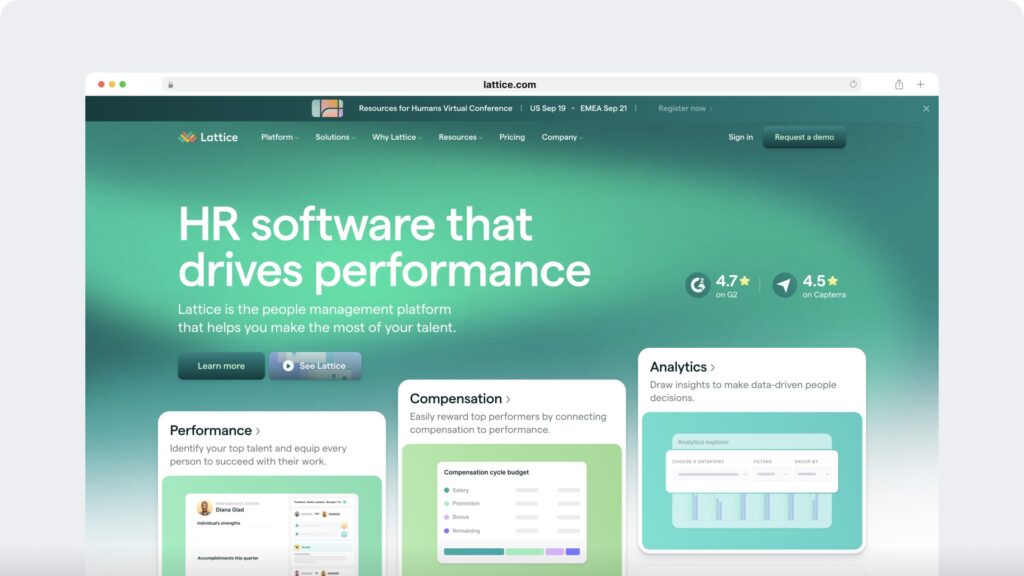
Lattice is HR software that measures employee performance and tracks goals. You can set up performance reviews, keep track of 1:1s, request employee feedback, and create career development plans.
You can also measure goal progress using the framework that matters to your team so you know exactly who’s on target.
Leapsome
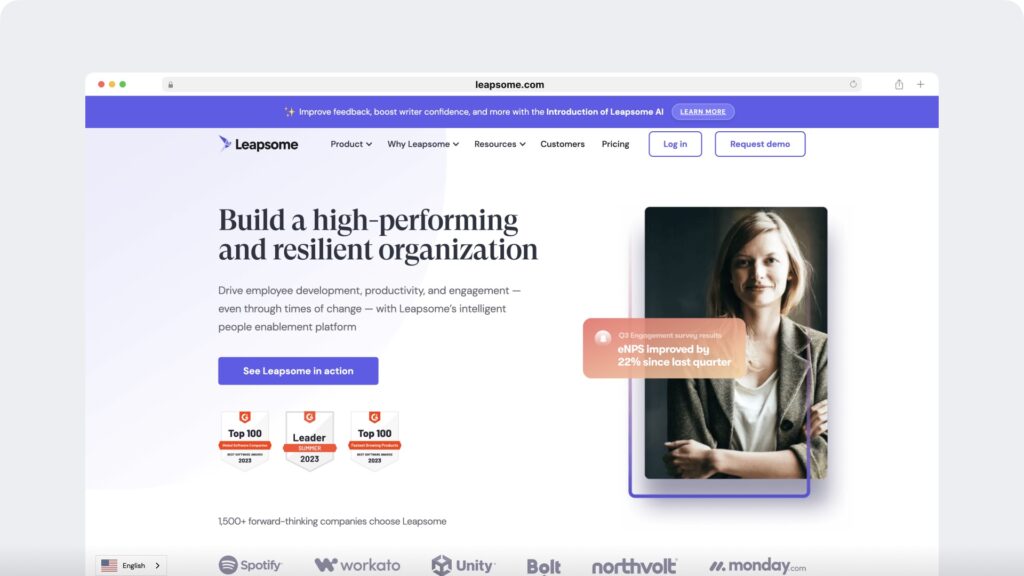
Leapsome is an employee development and engagement platform supporting multiple types of reviews.
With Leapsome, you can manage 360-degree reviews with feedback from peers and supervisors. You can also create custom reviews and set up cycles to ensure employees get the input they need to continue improving.
Personal productivity tools
Employees who want to track their performance independently have several options for monitoring time and KPIs.
Spreadsheets
Tools like Google Sheets and Microsoft Excel offer easy entry points for employees seeking to self-monitor their performance. These flexible programs allow employees to create customized goals and tracking systems based on the metrics that matter to them.
Since both tools have built-in charts and graphs, they can also help employees visualize their performance. Because Google Sheets are easy to share, employees can give managers access to additional oversight.
Project management tools
Whether it’s Asana, Trello, ClickUp, or other popular project management tools, employees can employ them to stay on track. If your team already uses these platforms, they give employees an easy way to monitor basic KPIs.
Most tools in this category automatically track the number of tasks each team member completes. Some also monitor the number of jobs completed on time or allow you to measure based on other metrics.
Time tracking tools
If your organization is less concerned with task completion and more interested in employee time and schedules, time tracking tools can help. Some project management tools (e.g., Asana) already have built-in time trackers.
Employers can also use free time trackers for individuals. For example, Toggl Track and Clockify each offer free browser-based time tracking apps that employees can operate independently.
Productivity analytics tools
When you’re ready to automate performance tracking, you need a reliable tool for the job. The following productivity analytics platforms monitor your team and provide insights you can access around the clock.
Time Doctor
Time Doctor is an employee monitoring software platform that tracks time, activity, and productivity. It records how long employees work each day, including idle time.
Since the platform monitors the apps and websites employees use and the tasks they complete, it automatically creates timelines for each workday.
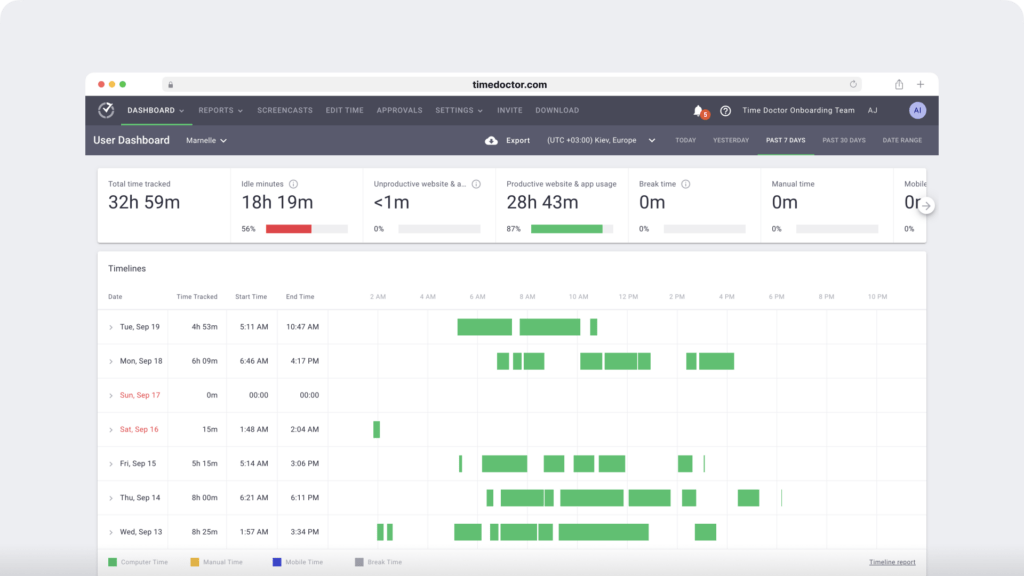
As a manager, you can classify websites and apps as productive or unproductive, depending on the tasks your employees need to complete. Time Doctor then keeps track of each team member’s productive and unproductive time based on their activity throughout the day.
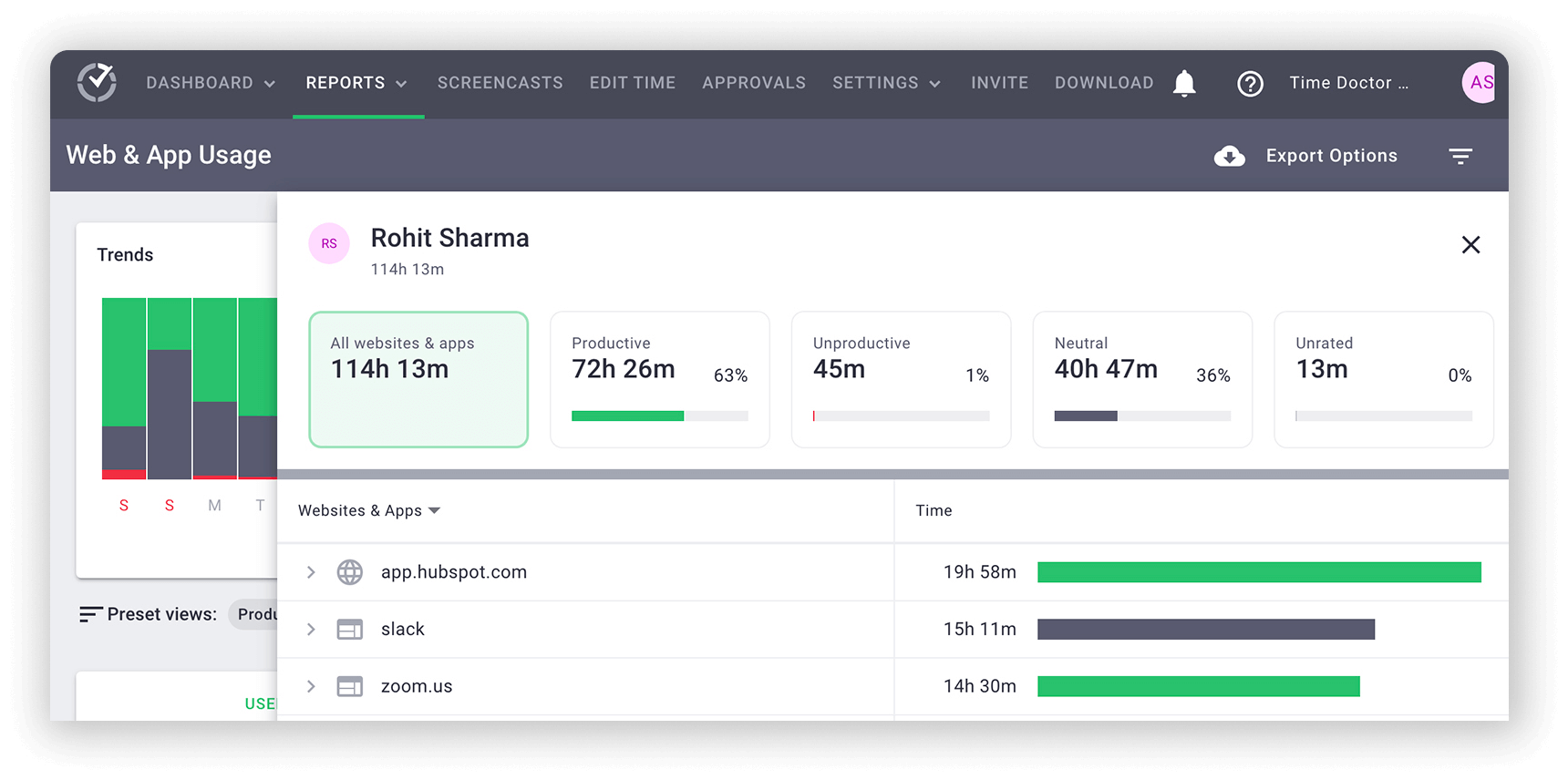
These insights are ideal for benchmarking and measuring performance. For example, you could set a goal for all employees to reach 90% productivity or ask underperforming employees to decrease idle time by 10% each month.
Using Time Doctor’s charts and insights, you can also look for trends and patterns. You might find that some employees spend more time on certain tasks, apps, or websites than usual. If these activities slow progress on other tasks, you can invest in improving workflows or rethinking your tech stacks.

With Time Doctor’s work-life balance report, you can spot which employees are working too hard. You can intervene before they hit the burnout point. Since this report is based on your own custom settings, you can ensure employees meet your company’s work-life balance standards.
ActivTrak
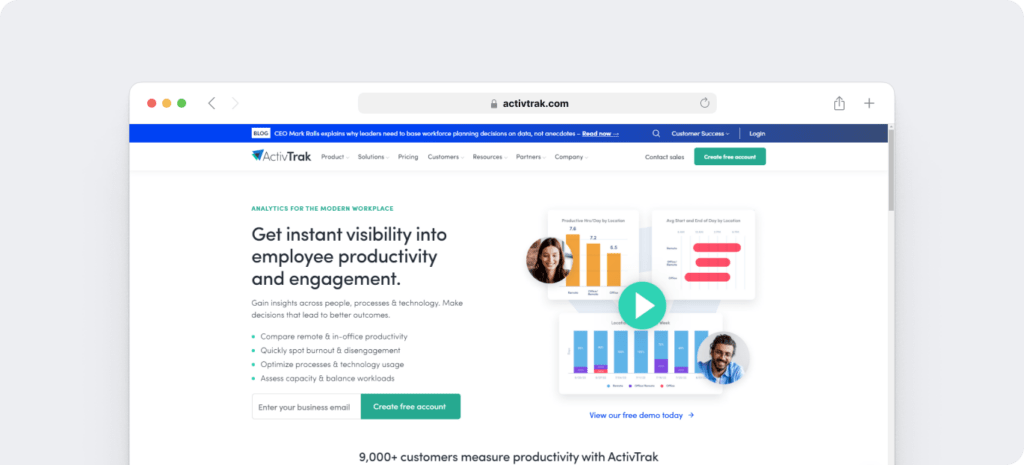
ActivTrak is a workforce analytics platform offering insights into employee productivity and engagement. You can monitor individual and team performance and compare productivity across remote and in-office locations.
This platform’s design can also optimize workloads and identify work-life balance issues.
Insightful
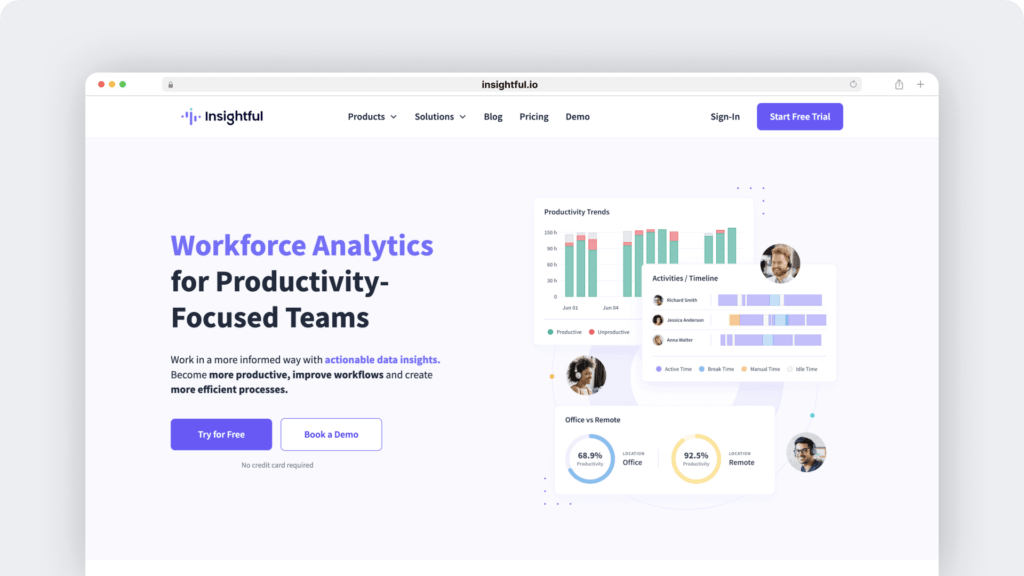
Insightful is another workforce analytics platform designed to increase employee productivity. It automatically identifies productive and unproductive time to improve employee focus and analyzes tasks and processes to help your team manage resources more effectively.
Getting started with employee performance tracking
How might a data-driven performance management system benefit your hybrid, remote, or in-office team? Book a Time Doctor demo to see how our productivity analytics platform can boost employee performance and enhance your workflow efficiency.

Carlo Borja is the Content Marketing Manager of Time Doctor, a workforce analytics software for distributed teams. He is a remote work advocate, a father and a coffee junkie.


